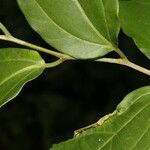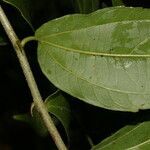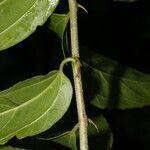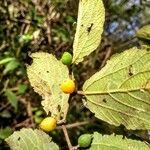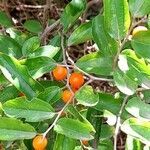Climber, shrub or treelet, up to ca. 6 m tall, with solitary or paired, up to 1.5 cm long, curved spines. Branchlets 1-4 mm thick, puberulous to pubescent or subglabrous. Stipules 0.2-0.5 cm long, puberulous to subglabrous, caducous; petiole 0.5-1.5 cm long; blade chartaceous, narrowly ovate to ovate to narrowly elliptic to elliptic, 3-14 x 2-6.5 cm, apex acute to acuminate, base obtuse to subcordate, margin serrate to crenate-dentate, both surfaces smooth to scabridulous, puberulous to hispidulous to pubescent or subglabrous; secondary veins 2-4 pairs. Inflorescences in the leaf axils or just below the leaves. Staminate flowers sessile; tepals 5, 1-1.5 mm long. Pistillate flowers short-pedicellate; tepals 5, ca. 1.5 mm long; stigmas 5-8 mm long. Fruit ellipsoid to ovoid, (when dry) ca. 10-15 mm long, at maturity orange to red.
A small tree. It grows to 4 m high. The trunk is 12-15 cm across. The branches are horizontal. They are flexible and have spines. It can form thickets. The leaves are alternate and have teeth along the edge. They are 5-7 cm long by 2.5-4 cm wide. They are oval and taper to the tip. The flowers contain both sexes. The fruit is fleshy and with a hard stone inside. The fruit are green when immature and yellow when ripe.
